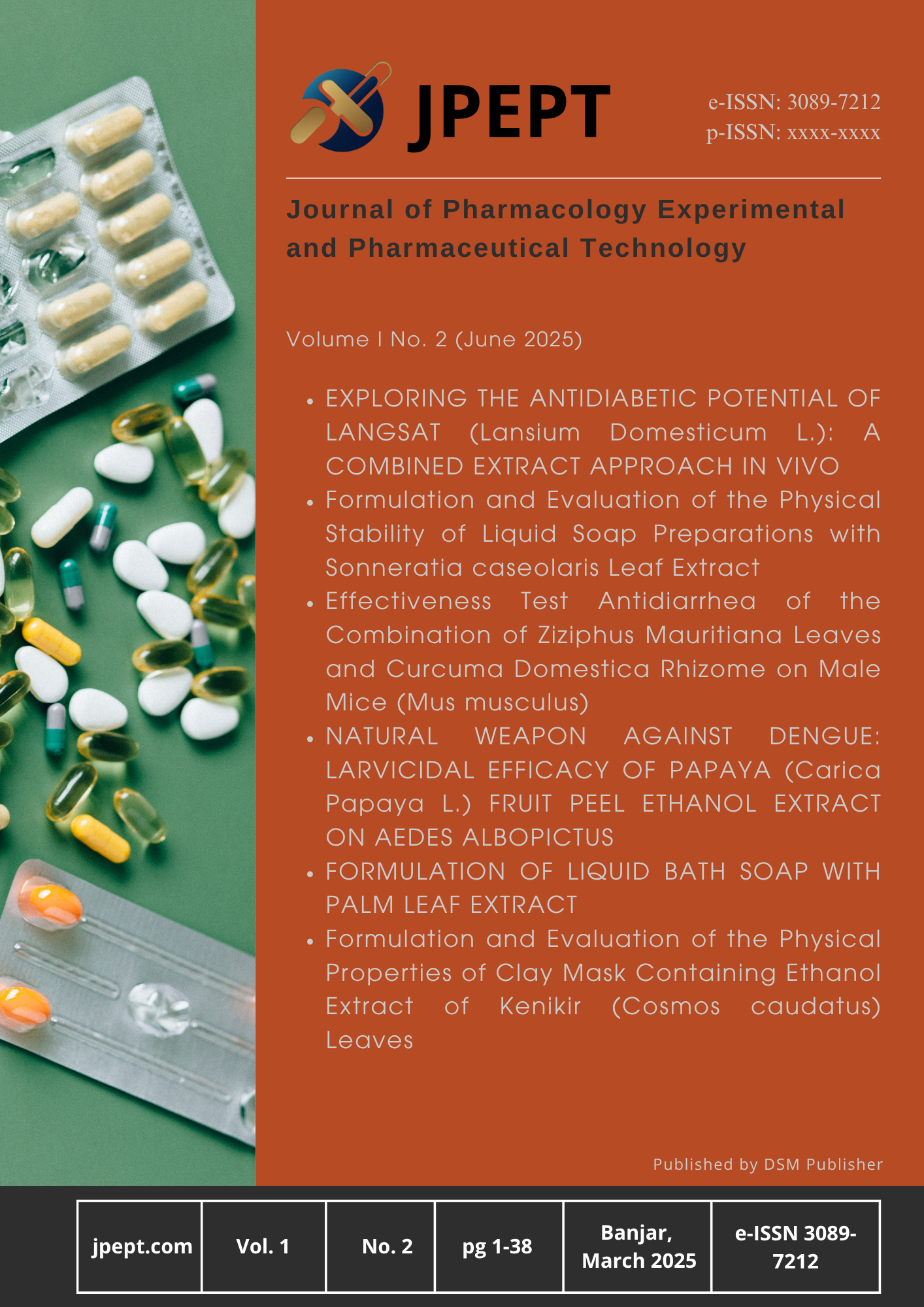EXPLORING THE ANTIDIABETIC POTENTIAL OF LANGSAT (Lansium Domesticum L.): A COMBINED EXTRACT APPROACH IN VIVO

Published 2025-07-18
Keywords
- DM, Glucose, Lansium domesticum, Langsat, Extract
Abstract
Diabetes Mellitus is a chronic condition caused by increased blood glucose levels due to the body no longer being able to produce enough insulin hormone or use insulin effectively. Traditional medicine has long used Langsat, a native plant of Indonesia. Langsat is widely used by the community in treating various diseases, including as a worm medicine, fever medicine, diarrhoea medicine, and cancer medicine. This study aims to find out how well a mix of antidiabetics works with EKDL (Lansium domesticum L) in lowering blood sugar levels in male white mice (Mus musculus) and to figure out the best dose of EKDL for reducing blood sugar in the mice. Experimental research method using 35 white male mice divided into 7 groups, each group containing 5 mice, namely negative control, positive control, EK, ED, EKKDL 1:1, EKKDL 2:1, and EKKDL 1:2. The results of the ANOVA test of the EKKDL dose 1:2 (200 mg / 240 mg / kgBW) were effective in reducing blood sugar levels in mice. Analysis of blood sugar level data of mice using paired T-tests and post hoc. The results of the paired t-test showed a significant difference in blood sugar levels after treatment (p <0.005) and the results of the post hoc test showed that there was a significant difference (p < 0.005) and there was no significant difference (p > 0.005) between all EKKDL in reducing blood sugar levels in mice. The combination of langsat skin and leaf extract (Lansium domesticum L.) has effectiveness in reducing blood sugar levels in experimental animals.
References
- Antar, S. A., Ashour, N. A., Sharaky, M., Khattab, M., Ashour, N. A., Zaid, R. T., Roh, E. J., Elkamhawy, A., & Al-Karmalawy, A. A. (2023). Diabetes mellitus: Classification, mediators, and complications; A gate to identify potential targets for the development of new effective treatments. Biomedicine and Pharmacotherapy, 168, 1–25. https://doi.org/10.1016/j.biopha.2023.115734
- Ardi, A., Sumantri, D., & Adnan, S. (2016). In Vitro Antibacterial Activity Assay of Langsat (Lansium parasiticum) Peel Extract Against Enterococcus faecalis Growth. 8(1), 1–5.
- Indriyani, S., & Mustarichie, R. (2020). Review of Antidiabetic Activities of Several Plants in Indonesia. Farmaka, 18(1).
- Vaou, N., Stavropoulou, E., Voidarou, C., Tsigalou, C., & Bezirtzoglou, E. (2021). Towards advances in medicinal plant antimicrobial activity: A review study on challenges and future perspectives. Microorganisms, 9(10), 1–28. https://doi.org/10.3390/microorganisms9102041
- Yedjou, C. G., Grigsby, J., Mbemi, A., Nelson, D., Mildort, B., Latinwo, L., & Tchounwou, P. B. (2023). The Management of Diabetes Mellitus Using Medicinal Plants and Vitamins. International Journal of Molecular Sciences, 24(10), 1–14. https://doi.org/10.3390/ijms24109085
- Pertiwi HR, Mahdi Nur, Saiful RS. (2024). In Vivo Analgesic Effect Test of Ethanol Extract of Langsat Fruit Peel (Lansium domesticum var. pubescens). Jurnal Mandala Pharmacon Indonesia 10 (2). https://doi.org/10.35311/jmpi.v10i2.601
